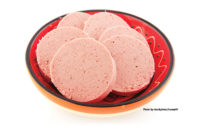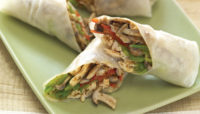'Encase' You Wondered

I live a few miles west of Wrigley Field, on Chicago’s North Side. I am near Hot Doug’s, the self-acclaimed “sausage superstore” that made international headlines a few years ago after being fined for serving a homemade duck sausage topped with truffle Dijon mustard and the then-banned foie gras. By the time the city council of the Windy City realized how ridiculous the ban was and lifted it, owner Doug Sohn paid $250 in fines. When you compare this fee to the cost of advertising, Sohn looks like a genius, as his “encased meat emporium” became a destination for sausage lovers from around the world thanks to global media attention given to Chicago’s foie gras controversy.
Sohn’s menu includes basics such as Chicago-style hot dogs, Polish sausage and bratwurst, as well as an array of gourmet, upscale encased meats. For example, there’s a bacon and cheddar elk sausage, spinach and mozzarella chicken sausage and apple and garlic lamb sausage. Simple or exotic, the one thing all of Sohn’s sausages, and for that matter, most sausages, have in common is casing.
Casings function as a transparent skin to sausage. They are an ultra-thin material that holds all of the ingredients together and at the same time contributes to color, flavor and eating quality.
Historically, sausage makers have used natural casings, which are the cleaned and fat-stripped intestines from cows, hogs or sheep. Such casings are essentially all collagen, and to prevent microbial growth prior to stuffing, they are usually held in brine.
Hog casings, the most widely available, and thus the most popular of the three, can be used for almost any kind of sausage. Sheep casings are very tender and are used for sausages such as breakfast links and hot dogs. Beef casings run on the thick side, and are used for firm sausages such as bologna and salami. Beef casings are larger in diameter than hog or sheep casings and also are more uniform in diameter.
Regardless of the animal source, natural casings are recognized for enhancing and complementing the natural juices and quality of the meat and spices. The collagen allows for deep smoke penetration, which is important to the flavor and preservation of many sausages. Natural casings also have excellent characteristics of elasticity and tensile strength, allowing for high-efficiency production and expansion during filling. They protect flavor without contributing any off-flavors, and help sausage stay tender and juicy. And finally, the attribute that consumers recognize, naturally cased sausages have a special “snap” and tender bite that most man-made casings cannot provide.
As with any minimally processed food or ingredient, natural casings can vary in composition and quality. They also are readily influenced by the environment, meaning that the smoking and cooking of the sausage must be controlled, as must storage temperature and humidity.
Man-made casings are also an option. These are often based on collagen or cellulose, and are usually a much more economical option than natural casings. Vegetarian casings based on gums, such as agar and xanthan, are also available. All man-made casings allow for uniform diameter links and result in fewer casing bursts.
Collagen casings are made from the same gelatinous material used to make gelatin dessert. The collagen is sourced from the bones, cartilage, connective tissue and skin of animals, traditionally cows. Most commercially purchased sausage in the United States is stuffed into collagen casings.
Cellulose-based casings, also referred to as fibrous casings, are the toughest casings produced and are considered inedible. They are for sausages that require maximum uniformity of the finished product diameter, such as sausages sold at retail and packaged at predetermined weights, e.g., 8-ounce salami. They are also ideal for deli-style meats, e.g., bologna, where uniformity of product makes it easier to slice.
Fibrous casings tend to adhere to the underlying sausage, which results in tearing or scarring of the meat. To overcome this, suppliers will often coat the fibrous casing with alginates to improve peelability.
Sausage makers must evaluate the properties of each type of casing for each sausage recipe to determine the best match. In addition to differences in cost, casings vary in how they respond to smoking, cooking and finished product appearance.
So, in case you want to start making sausages, just remember, what goes inside the casing is as important as the casing itself.
Photo courtesy of Farmland Foods
Looking for a reprint of this article?
From high-res PDFs to custom plaques, order your copy today!





